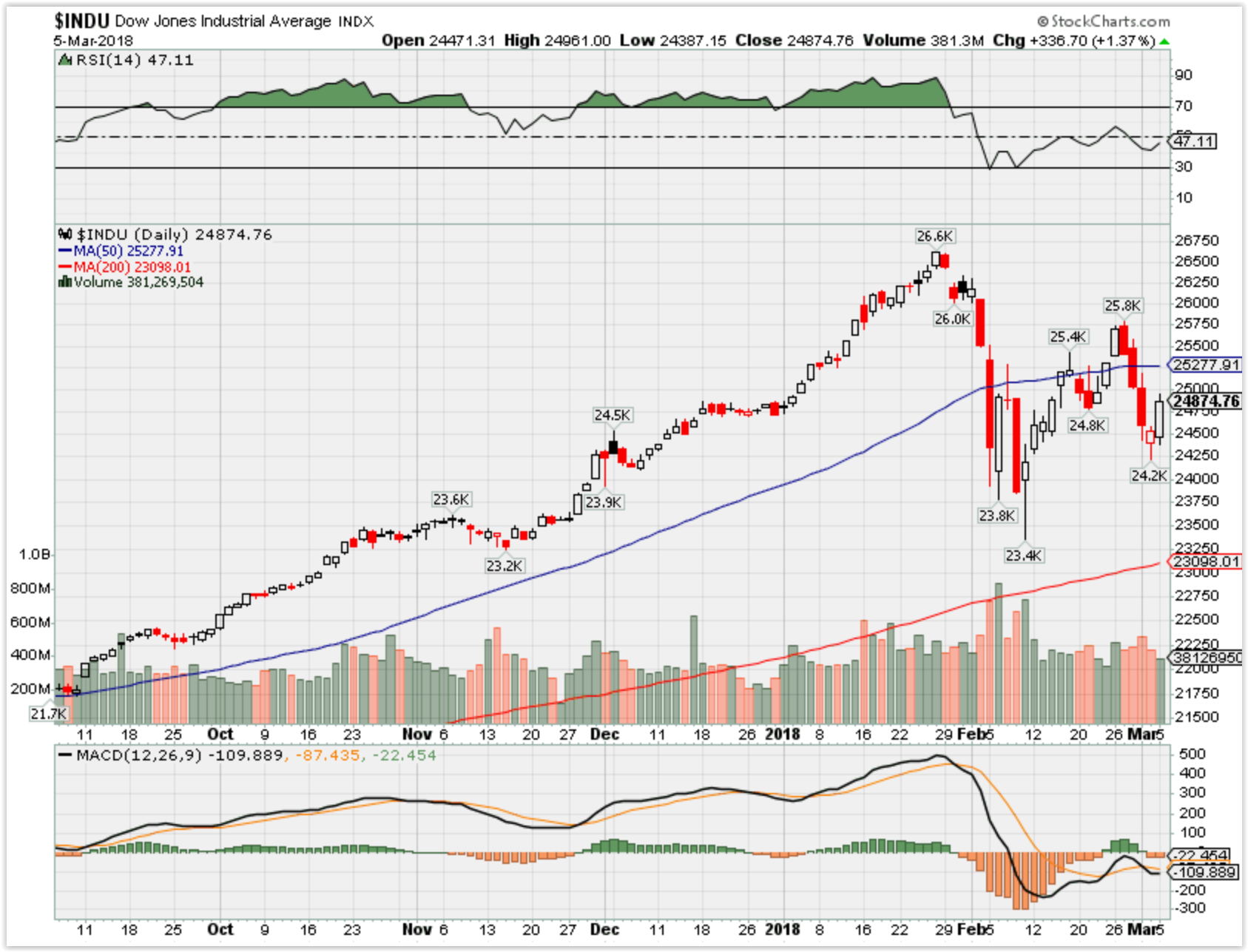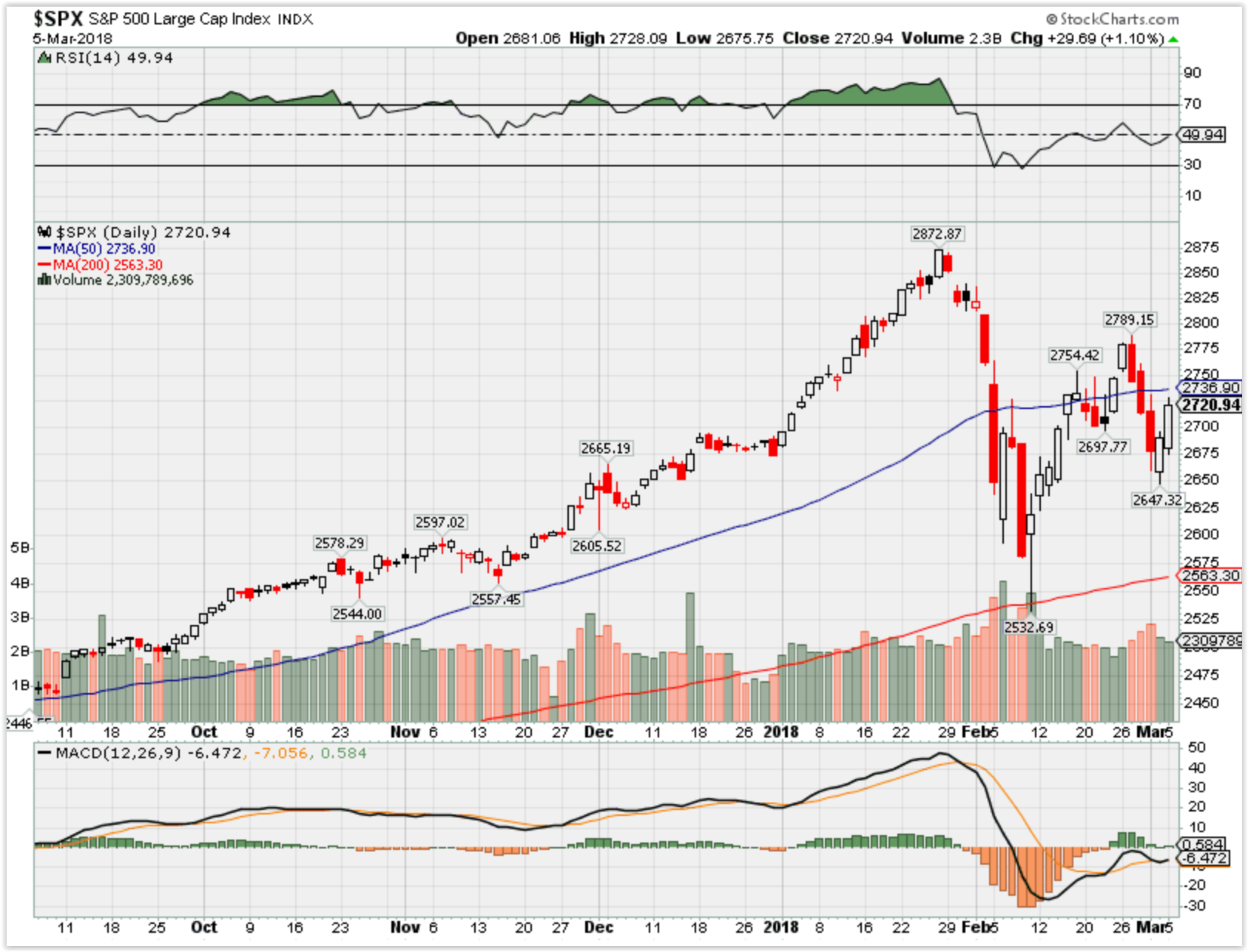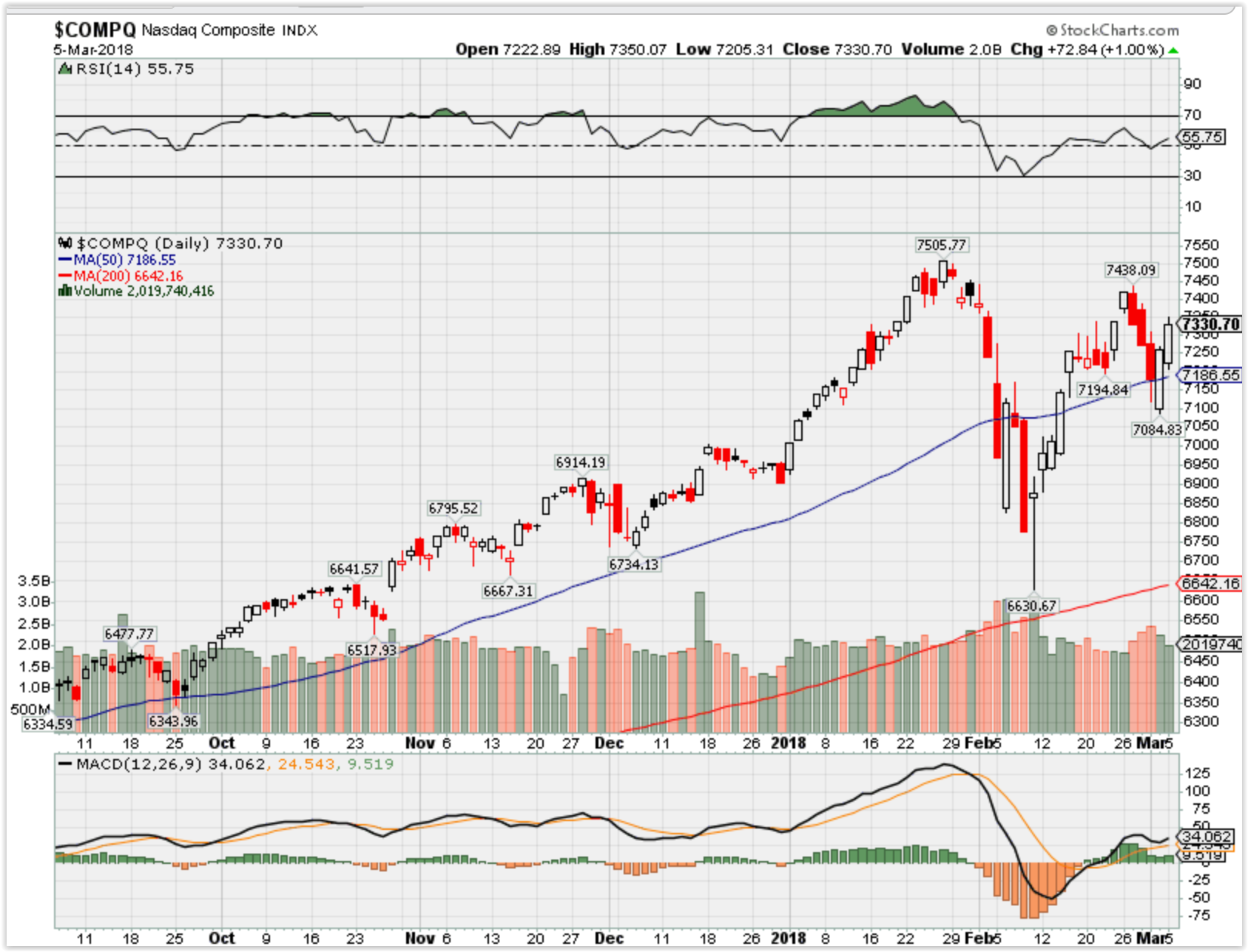HI Financial Services Commentary 03-05-2018
What I want to talk about today?
Headline trading and what I am looking at NOT doing IS looking to HAVE to place new money into positions without a reason (technical, macro, news )
Don’t trade a collar during stagnant movements of stock ownership
Why I’m looking a stagnant to flat month in March – NO selling of stocks end of last year, Tax selling for 2017
Bigger swings on a point basis with relatively close percent’s swings that we’ve seen on the past
Very difficult to do Because…. It is nothing more than a guess
What happening this week and why?
DJIA +336.70 or 1.37%
S&P 500 +29.69 or 1.10%
Nasdaq +72.84 or 1.00%
Where will our markets end this week?
Higher
SPX – Bearish
COMP – Bullish
Where Will the SPX end March 2018?
03-05-2018 -2.0%
02-28-2018 -3.0%
What is on tap for the rest of the week?=
Earnings:
Tues: TGT, ROST, URBN
Wed: ANF, DLTR, CLDX, COST, VSLR
Thur: AEO, BURL, KR, SHLD, MRVL
Fri: BIG,
Econ Reports:
Tues: Factory Orders
Wed: MBA, ADP Employment, Productivity, Unit Labor Costs, Trade Balance, Consumer Credit
Thur: Initial, Continuing Claims,
Fri: Average Workweek, Non- Farm Payroll, Private Payroll, Unemployment Rate, Hourly Earnings, Wholesale Inventory
Int’l:
Tues –
Wed – CN: Merchandise Trade Balance, JP:GDP
Thursday – JP: Bank of Japan Announcement, CN: CPI, PPI
Friday-
Sunday –
Questions???
Yes owning AAPL is a value investments with more potential upside
www.myhurleyinvestment.com = Blogsite
customerservice@hurleyinvestments.com = Email
How am I looking to trade?
I will have Long puts sell shares on DHI,
KMX – 04/04 BMO
David Einhorn’s hedge fund was crushed — again — in February
- Both Greenlight Capital and the Greenlight Capital Offshore fell by 6.2 percent in February, according to David Einhorn’s monthly update to investors, as seen by CNBC.
- The fresh round of losses extends the hedge fund’s decline in 2018 to more than 12 percent.
- Greenlight Capital has been under-performing the S&P 500.
Published 11:11 PM ET Wed, 28 Feb 2018 Updated 8:36 AM ET Thu, 1 March 2018
David Einhorn’s Greenlight Capital suffered another round of losses in February — extending the hedge fund’s decline in 2018 to more than 12 percent.
Both the main Greenlight Capital fund and the Greenlight Capital Offshore fell by 6.2 percent in February, according to Einhorn’s monthly update to investors, which was obtained by CNBC.
Greenlight Capital and Greenlight Capital Offshore declined by 6.6 percent and 6 percent, respectively, in January.
The hedge fund has been under-performing the S&P 500 in 2018.
The S&P had its best January in two decades, rising 5.6 percent that month. It subsequently lost around 3.8 percent in February, to bring the year’s gain to 1.8 percent.
Einhorn had said in a conference call last week that the company has “never underperformed like this.”
— CNBC’s Scott Wapner contributed to this report.
https://www.cnbc.com/2018/03/05/fidelity-puts-6-million-savers-on-a-risky-path-to-retirement.html
Fidelity puts 6 million savers on a risky path to retirement
- For three years, the mutual funds in Fidelity’s flagship retirement franchise have outperformed at least 85 percent of their competitors.
- Yet client money has continued to flow out of the firm’s Freedom Funds as retirement plan sponsors shift workers’ savings to rivals in the target-date fund business.
- A recent global market sell-off underscored how Fidelity’s growing appetite for risk could amplify investor losses.
Published 10 Hours Ago Updated 1 Hour Ago
For three years, the mutual funds in Fidelity‘s flagship retirement franchise have outperformed at least 85 percent of their competitors, reversing a decade-long trend of subpar performance.
And yet client money has continued to flow out of the firm’s Freedom Funds as retirement plan sponsors shift workers’ savings to rivals in the target-date fund business.
While deposits in the trillion-dollar sector have surged, Fidelity has seen nearly $16 billion in net withdrawals over the past four years, according to research firm Morningstar.
The exodus stems in part from unease with the way Boston-based Fidelity has boosted performance – by ramping up risk.
Since a strategy overhaul that took full effect in 2014, Fidelity has substantially increased exposure to stocks, including those from volatile emerging markets. The firm also scrapped a long-held belief of sticking to pre-set allocations of stocks, bonds and other assets in target-date funds.
Instead, Fidelity portfolio managers now try to time market shifts, for instance by moving billions of dollars out of money-losing commodities bets and into Chinese stocks and U.S. tech shares, regulatory filings show.
Such changes have worked well in the second-longest running bull market in U.S. history, but they expose investors to bigger losses if the funds’ increasingly volatile assets head south.
In the 1990s, Fidelity helped pioneer target-date funds as a prudent method to diversify investments and automatically dial down risk as participants age. The fund names typically include a projected retirement year – the target date.
Today, many target-date fund managers have turned to riskier investments to boost returns, and Fidelity has gone further than its peers, said Ron Surz, president of research firm Target Date Solutions.
“These funds with high concentrations in stocks are a time bomb,” Surz said.
The sector is even riskier today than during the 2008 financial crisis, when some funds dropped more than 40 percent, he said.
Fidelity spokesman Vincent Loporchio said today’s American savers can handle more risk because they retire later and live longer, allowing more time to recover losses.
“The Freedom Funds are a lifetime savings solution,” he said, that”deliver exceptional performance for shareholders taking appropriate risks.”
A recent global market sell-off underscored how Fidelity’s growing appetite for risk could amplify investor losses.
The Freedom 2020 Fund – for investors two years from retirement – fell 6 percent between Jan. 26th and Feb. 8th, performing worse than 81 percent of competitors’ similar target-date funds, according to Morningstar.
The sharp downturn reflects Fidelity’s decision to keep 60 percent of 2020 investors’ money in stocks compared to an average of 40 percent in similar funds for older savers, according to Morningstar.
The 2040 fund, for mid-career savers, tumbled 9 percent during that period, lagging 87 percent of rivals, after outperforming almost all competitors over the past year as stocks generally surged. The 2060 fund for young investors did better, beating 60 percent of rivals during the market sell-off.
Loporchio said such short-term swings do not reflect what Fidelity’s retirement savers will see over the long term. With its 2014 strategy changes, Fidelity needed to address a longstanding problem with underperformance of Freedom Funds, Loporchio said.
“When Fidelity products yield disappointing returns, we work relentlessly to improve them,” he said.
In the decade before the changes, Freedom Funds largely failed to beat or match their internal benchmarks, set by Fidelity, over one-, three-, five- and 10-year spans, according to a Reuters analysis of the firm’s performance data. Had the funds been a sports team, their record against benchmarks would have been six wins, 40 losses and one tie.
About 6.2 million Americans have about $224 billion invested in Freedom Funds, Fidelity’s largest retirement fund franchise. The funds account for about 10 percent of the firm’s assets under management and generate fee revenue approaching $1 billion annually.
But the funds’ market share has plunged to 21 percent of total target-date fund assets, down from 43 percent at the end of 2008, according to Morningstar data.
Of the top five target-date providers, Fidelity was the only one to have net withdrawals in 2016 and 2017, according to Morningstar data. By contrast, the target date industry as a whole racked up $129 billion in net deposits during those two years.
‘Chaotic’ changes
Retirement plan sponsors and consultants who have pulled money from Freedom Funds told Reuters that they lost faith in Freedom Funds because of their history of underperformance, frequent strategy changes and rising risk.
Dassault Systemes, a French software company with U.S. operations, is among those who dumped Freedom Fund investments soon after the strategy revamp. Fidelity’s”tinkering” with the funds’ methodology for dialing down investor risk over time raised concerns about the funds’ management, said Longfellow Advisors, an outside consultant hired by Dassault, in a report to the company.
“It was not clear to us that they knew what they were doing,” Kendall Storch, a Longfellow principal who consulted Dassault on the change, told Reuters in an interview.
Plan sponsors dumping Freedom Funds more recently include a host of college retirement systems that shifted money in 2017 to target-date funds offered by Vanguard, according to announcements by the plans. They included Central Florida University, Dartmouth College, Duke University, Santa Clara University and the University of Virginia Physicians Group Retirement Plan.
El Camino Hospital in Silicon Valley replaced Freedom Funds with T. Rowe Price’s target date offering in 2015, citing historic underperformance and the new”attempt to time global markets,” according to a February 2015 investment committee meeting report.
“Fidelity has made a lot of changes all at once,” said Scott Cameron, chief investment officer at retirement consultant Multnomah Group, which advised El Camino Hospital on the change. “It does cause clients to pause.”
It’s not the first time Fidelity has been criticized for strategy changes that unsettled investors and analysts. When Morningstar looked at Fidelity’s changes in the allocation of stocks between 1996 and 2010, they described them as”shocking” and “seemingly chaotic,” according to a 2011 Morningstar report on the target-date fund industry.
Fidelity said its new market-timing strategy, which it calls”active asset allocation,” can capitalize on finding underpriced assets over a 1-to-5 year time horizon. Since 2014, Freedom Fund portfolio managers have had discretion to adjust allocations in major asset classes by up to 10 percentage points in either direction.
Loporchio said that the investment management for a target-date fund”should be flexible and adaptable, to evolve and respond to changes in both the capital markets and investor needs.”
Trying to ‘not lose money’
Fidelity has historically frowned on market-timing strategies in retirement funds, saying they had a “low probability of repeated success,” according to a 2009 presentation Fidelity gave to the Vermont state and municipal retirement system. Reuters obtained the slide deck through a public records request.
Instead, Fidelity restricted Freedom Fund managers to pre-determined asset allocation formulas, with specified percentages of stocks, bonds or other assets.
The Freedom Funds, launched in 1996, dominated the sector for years. As the top U.S. record keeper for 401(k) and other defined contribution retirement plans, Fidelity had outsized influence on what investment options were offered to workers at hospitals, municipalities, publicly-traded companies and universities.
But the funds lost ground in the mid-2000s as rival Vanguard Group overtook them with its cheaper index target-date funds.
Until the changes in 2014, Fidelity funds held higher concentrations of more conservative investments such as bonds, aimed at protecting investors against the downside risk of market cataclysms.
Even with a more conservative asset mix than Freedom Funds have today, Fidelity struggled to control the damage from the 2008 financial crisis, when the funds performed as poorly as the rest of the sector, losing 41 percent for the youngest savers and 25 percent for those near retirement.
This time around, Freedom Funds are more exposed to equities and other higher-risk assets, according to analysts and a Reuters review of Fidelity’s U.S. regulatory filings.
And the stakes are much higher now: The popular target-date fund sector now has more than $1 trillion in assets under management – or more than five times as much as before the 2008 meltdown.
Despite Fidelity’s rapid loss of market share, Freedom Fund assets have more than doubled in the past decade as the stock values surged.
Fidelity has gone further than competitors in boosting risk to juice returns in a low-interest rate environment, fund disclosures show.
For example, Fidelity’s Freedom 2020 Fund – marketing to people retiring in about two years – has 60 percent of its assets in equities.
By contrast, 2020 funds run by T. Rowe Price Group, Vanguard Group and American Funds have 58.5 percent, 55 percent and 49 percent, respectively, in equities, fund holding disclosures show.
Fidelity’s 2020 fund includes 6.4 percent of its $31 billion in net assets in emerging market equities, such as Chinese stocks, according to company disclosures. That’s up from about 1 percent a decade ago in an similar Fidelity fund for older savers, according to a returns-based estimates by software and research firm Markov Processes International.
The current exposure is significantly higher than the category average of about 4 percent in 2020 funds, according to MPI’s analysis.
Emerging markets, in particular, can be more volatile than the U.S. stock market because they can feature foreign currency exchange risk, political instability and limited liquidity. In the summer of 2015, for example, the Shanghai Composite Index .SSEC fell more than 40 percent in a sell-off that reverberated around the globe amid worries about China’s slowing economy.
Freedom Fund portfolio managers and quants are experimenting with artificial intelligence and algorithms similar to ones used by hedge funds to identify hidden shifts in the market to adjust investment allocations, according to Fidelity’s published research.
The changes have paid off in the short run, with Freedom Funds’ 1-year and 3-year returns beating internal benchmarks. Fidelity also credited junk bonds for helping bolster returns, according to portfolio manager commentary posted on its website.
In the long run, the biggest risk in target-date funds is that they won’t meet investor expectations for avoiding losses, said Morningstar analyst Jeff Holt.
The funds, he said, are so popular in part because investors believe they are designed to”not lose money.”
A trade war would be painful for markets, but long-time bull Jeff Saut isn’t heading into the bear camp
Stephanie Landsman | @stephlandsman
Published 4:59 PM ET Sat, 3 March 2018 Updated 5:37 PM ET Sat, 3 March 2018
If President Donald Trump’s tariffs go into effect, one of Wall Street’s long-time bulls suggests stocks will get hammered.
Raymond James’ Jeffrey Saut says the safest place for investors is on the sidelines until there’s more clarity.
“If this spills over into a full-blown trading war, then I have no idea where the bottom is going to be in this,” the firm’s chief investment strategist said Friday on CNBC’s “Trading Nation.” “I’m just kind of sitting on my hands right here until the dust clears.”
On Thursday, Trump announced the United States will institute tariffs on steel and aluminum as early as next week. The news sparked a deep stock sell-off. For the week ending Friday, the Dow fell 3 percent and the S&P 500 dropped 2 percent.
“We’ll have to see what happens in the next couple of weeks because I think it’s going to take that long to sort it out,” he added. “If you’re going to see a retaliatory move, you’re going to see it in the next couple of weeks.”
The move would anger the global community and potentially create shock waves through the market, according to Saut.
But Saut, who acknowledges the tariff announcement surprised him, isn’t abandoning his secular bull market view.
He contends the strength of economic and earnings growth could keep stocks fundamentally sound for as long as a decade. Saut also cites under-investment as a long-term bullish signal.
“I do think it’s noise in the short run. I think it’s going to present a buying opportunity in the long run,” he said.
In the meantime, Saut isn’t willing to recommend buying stocks. He says it’s not unreasonable for the stock market to retest the February correction lows.
“I am not going to step in here and buy a falling knife,” Saut said.
https://www.cnbc.com/2018/02/28/us-stocks-interest-rates-fed-markets.html
Dow closes 380 points lower, snaps longest monthly win streak since 1959
- The major averages erased gains from earlier in the session to close sharply lower.
- The Dow and S&P 500 snapped 10-month winning streaks, their longest since 1959.
- The Nasdaq posted a monthly loss for the first time in eight months.
Published 9:30 AM ET Wed, 28 Feb 2018 Updated 7:28 PM ET Wed, 28 Feb 2018
U.S. stocks fell sharply in choppy trade Wednesday, giving up earlier gains, as Wall Street wrapped up a volatile month for the major averages.
The Dow Jones industrial average closed 380.83 points lower at 25,029.20, with Caterpillar as the worst-performing stock in the index.
More than half of the day’s losses came in the final hour of trading with the Dow losing more than 240 points in the final 60 minutes.
The S&P 500 pulled back 0.9 percent to close at 2,713.83, with energy as the worst-performing sector. The Nasdaq composite ended 0.8 percent lower at 7,273.01.
Jeff Kilburg, CEO of KKM Financial said the S&P 500 dipped below its 50-day moving average late in the session. “That forces some technical selling pressure and flushes out some weak longs,” he said.
Earlier in the session, the S&P 500 and Nasdaq rose as much as 0.6 percent and 0.7 percent, respectively. The Dow gained as much as 166.12 points.
The Dow and S&P 500 snapped 10-month winning streaks, their longest since 1959. The Nasdaq posted a monthly loss for the first time in eight months. For the month, the Dow and S&P 500 closed lower by 4.3 percent and 3.9 percent, respectively. The Nasdaq closed February down 1.9 percent.
February was a volatile month for stocks. The major averages dipped in correction territory earlier this month, falling 10 percent from record highs set on Jan. 26. The move lower came as fears of rising inflation sent rates higher and sent market volatility surging after a year of unprecedented calm.
“The volatility is being caused by one overarching theme: The market doesn’t know what to expect from the Fed,” said Tom Essaye, founder of The Sevens Report. “There’s uncertainty around that and it’s going to continue for the next several months.”
But the Dow, S&P 500 and Nasdaq had recovered some of those losses as of Wednesday’s close. The Dow and S&P 500 are 6 percent and 5.5 percent, respectively, below their all-time highs, while the Nasdaq was 3.1 percent away.
Stocks rose earlier on Wednesday as interest rates stabilized. On Tuesday, the 10-year U.S. note yield jumped about five basis points to over 2.9 percent after Federal Reserve Chair Jerome Powell hinted at the possibility of more than three rate hikes for 2018 in his testimony to Congress members.
Powell’s testimony also sent stocks reeling. The Dow closed nearly 300 points lower, while the S&P 500 and Nasdaq finished the previous session down 1.3 percent and 1.2 percent, respectively.
“Valuations keep getting stretched,” said Eric Ervin, CEO of Reality Shares. “As long as rates remain low, the market can justify them. But as rates go higher, then we have to have higher earnings growth. The question is can companies sustain this.”
Powell is scheduled to testify in front of Congress again on Thursday.
In corporate news, home improvement retailer Lowe’s reported weaker-than-expected quarterly earnings, sending the company’s stock down more than 6 percent.
Booking Holdings — formerly known as Priceline — saw its shares spike more than 6 percent after reporting better-than-expected adjusted earnings.
Correction: Powell is scheduled to testify in front of Congress on Thursday. A previous version of this story misstated the day.




HI Financial Services Mid-Week 06-24-2014